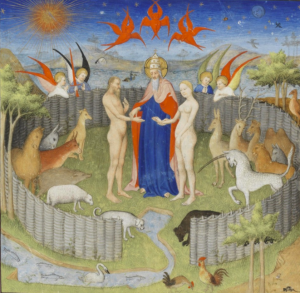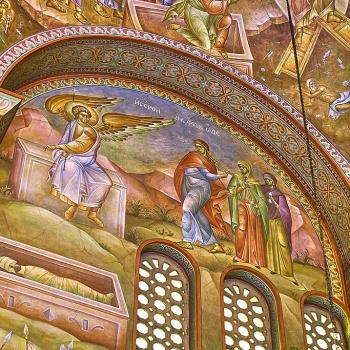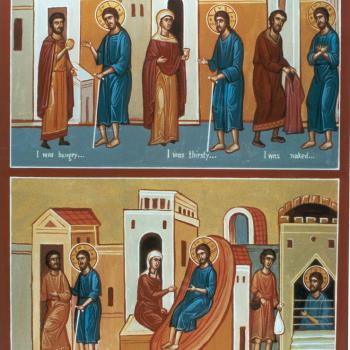
Despite Gnosticism being understood as a heresy which rejects many basic teachings of the Christian faith, many of its dangerous elements have been embraced by Christians throughout the centuries. They never seem to be completely overcome. Someone or another will pick them up and use them in their thought, sometimes doing so in such a way, elements of Gnosticism can even be said to have influenced (and tainted) the development of Christian thought. One such influence can be seen in the antipathy many Christians have with material creation. Gnostics believed that matter was created by some sort of evil god, and this led them to denounce our bodies; they said our bodies should be understood as prisons, made out of evil matter, which the evil god use to trap our spirits, which they said was good and made by the good god. Salvation, to them, was what happened when our spirits were freed from their material bondage. To them, the resurrection should not be seen as some sort of bodily resurrection from the dead, but the revelation of the transcendence of the spirit (and when Christ seemed to have a body, that body, they said, was an illusion).
St. Augustine, once a follower of Mani (who is seen as a representation of one form of ancient Gnosticism), wrestled with Gnostic dualism, both fighting against it ideologically, but also against the way it helped shape and influence his thought. He was not always successful, as historians and theologians have noted many ways Manicheism continued to influence him even after he officially rejected it. This is not to say Augustine was a Gnostic heretic, because he was not. Augustine did his best to fight against Gnosticism. But, we must acknowledge that Augustine, like most of us, was not perfect, and many things which he took on and accepted in his youth shaped his thought patterns for the rest of his life. Thus, despite his best intentions, he could not overcome all the influences Gnosticism had upon him. Augustine’s importance to Christian history meant Gnostic dualism was able to use him to continue to seed Christian thought with its heretical takes. Those who engaged and followed Augustine’s thought uncritically would find themselves bringing up and promoting many of his Gnostic tendencies.
Sadly, it can be said, Augustine, and other early Christians, held a more negative opinion on the material world, and bodies in general, so that, even if they acknowledged there was good to the body, their own inclinations was the same as the Gnostics. This gave what Gnosticism needed to re-emerge throughout the centuries, each time taking the general antipathy to the body and using it to finally reject its value and the value of material creation. They at least led material being, and the body, being denigrated, as being seen as inferior to the spirit, with bodily impulses being seen as where sin was most encouraged. Those who were seen as more material than others, that is women, were therefore led to be seen as inferior to those who were seen as more spiritual, that is, men. Archbishop Joseph Raya, therefore, suggested that Christian history led to a disdain for women as a result of “Oriental” modes of thought: “The disgust felt for women owed its origin to Oriental modes of thought and the belief that the body was evil; therefore anything that produces bodies (that is, women) were doubly evil.”[1] Why does he talk about Oriental modes of thought? Because Gnosticism was, in many ways, seen to be influenced by the “Orient,” such as by Persian (Zoroastrian) dualism. Nonetheless, we must distinguish the two, for the way Gnosticism adapted such influence was rather poor: it represented those “Oriental” traditions just as badly as it did Christian traditions.
Patriarchal societies quickly took on such dubious Gnostic influences, and used them to establish hierarchies which promoted men over women. Some Christian thinkers ended of questioning if women were directly made in the image and likeness of God. Many concluded that men were made in the image of God, while women were made in the image of men, so that, though they could also be said to be made in the image and likeness of God, women imagined God in a derivative manner in comparison to men. Similarly, as men were seen as spiritual, and women material, men were seen as greater than women, because the spirit was seen to be greater than matter. Women, therefore, needed to be guided by men, just like the body needed to be guided by the spirit. It is not difficult to see the dualism behind this hierarchical approach, which is why to confront it, and show its error, all that needs to be done is show why such dualism fails: women are not less spiritual than men, women were made in the image and likeness of God as much as men, and material creation should not be seen as pitted against the spirit as if material creation is where evil thrives (after all, spiritual beings, like demons, show evil can equally thrive in the spiritual realm). Many theologians, understanding the problems which developed through the centuries, have made it clear that Christianity must purify itself of such Gnostic influences, and in doing so, help Christian thought properly develop to show what it can be when such ideologies are no longer tainting it:
An egalitarian notion of the imago Dei is the foundation of feminist theological anthropologies. However, in order to achieve this vision of the human, the underlying patriarchal world view that has shaped Christian tradition must be challenged and transformed. One cannot simply “add” women as equals and produce an egalitarian anthropology. That would merely insert women into a patriarchal structure while maintaining that structure. Ultimately, true equality will occur only with the radical reconstruction of Christian theology in light of critical insights. [2]
Sadly, many Christians, including Christian women, resist this, as they assume Christian theological reflection and tradition which come from the past must be better in all ways to what can be said and produced in the present age. This is rank idolatry, one which says we must sacrifice theological development, including the improvements we have made in society (treating women as equals, stopping slavery, denying the death penalty), for the sake of a rather demanding, and unchangeable idol. When they do this, to be sure, they are only selective as regards which tradition they follow. They ignore those, like St. Maximos the Confessor, who confirmed all should be seen as equals in Christ:
For numerous and of almost infinite number are the men, women, and children who are distinct from one another and vastly different by birth and appearance, by nationality and language, by customs and age, by opinions and skills, by manners and habits, by pursuits and studies, and still again by reputation, fortune, characteristics, and connections: All are born into the Church and through it are reborn and recreated in the Spirit. To all in equal measures it gives and bestows one divine form and designation, to be Christ’s and to carry his name. [3]
While many Christians have been teaching something similar to this since the beginning of the Christian faith, there remains much resistance to this fact, a resistance which likewise can be seen as old as Christianity itself. The apostles often were upset when Jesus talked with women, treating women as equals to men; that prejudice, which Christ fought against, is something which has consistently shown itself in the Christian tradition. We must work to overcome that prejudice. We must follow the lead of St. Maximos, confirming the way the gifts of the Spirit are open to everyone in equal measure, because they have equal dignity and value to God. All Christians, all who have been baptized into Christ, have become a christ in Christ, that is, they now carry the name of Christ upon themselves, and so they should be able to live their life with the dignity and authority that name gives to them. Until we do that, Christianity will be seen to be hypocritical by outsiders, for they will see the difference between Christ’s egalitarian teachings and the way of life promoted and preserved by the Christian faith.
[1] Archbishop Joseph Raya, The Abundance of Love: The Incarnation and Byzantine Tradition (Combermere, ON: Madonna House Publications, 1989; 3rd ed.: 2016), 118.
[2] Michelle A. Gonzalez, Created in God’s Image: An Introduction To Feminist Theological Anthropology (Maryknoll, NY: Orbis Books, 2007), 133.
[3] St. Maximus the Confessor, “The Church’s Mystagogy” in Maximus the Confessor: Selected Writings. Trans. George C. Berthold (New York: Paulist Press, 1985), 187.












